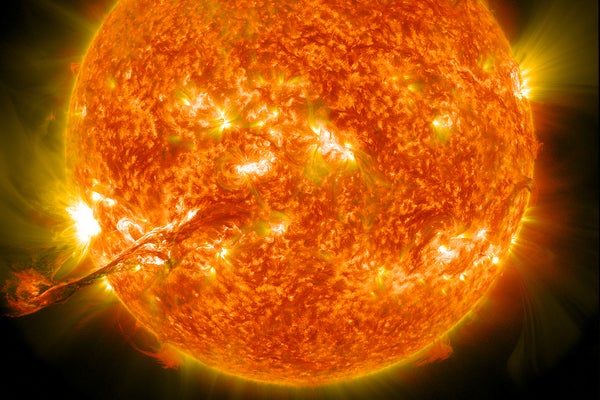January 3, 2024
4 min read
Middle-aged stars hit cruise control, stifling their magnetic fields and resisting the slowdown that scientists expected

As stars spin, they exhale a constant breath of charged particles that latch on to the star’s powerful magnetic field. Like a ballet dancer extending their arms, the magnetized stellar wind gradually slows a star’s rotation. The idea that older stars spin slower has been a central assumption in stellar astronomy for decades.
But over the past several years, a team of astronomers has begun to rewrite the ballet of stars. The researchers have realized that around halfway through their lives, stellar dancers pull in their arms and maintain a steady spin for billions of years. In a new study accepted for publication in the Astrophysical Journal Letters, the scientists investigate where this transition takes place. And their work suggests that the sun is already gearing up for its final tuck. The hypothesis has the potential to settle some long-standing mysteries about the sun and to aid the search for life beyond our solar system.
The idea that stars hit cruise control rather than keep slowing down faced a lot of resistance from astronomers at first, but confidence has built recently. “Observationally, the case is now compelling,” says David Soderblom, an astronomer at the Space Telescope Science Institute, who was not involved in the new study and was initially skeptical of the proposal. The growing findings point to a gap in our understanding of how stellar magnetic fields evolve over time. “That’s a big deal—that’s a whole aspect of solar physics that we’re not in touch with,” Soderblom adds.
Scientists first recognized in the 1970s that a star’s wind interacts with its magnetic field to create a “magnetic braking” effect that slows down its spin over time. In 2003 researchers started using this relationship to estimate a star’s age by measuring its rotation, now a widely used process known as gyrochronology. All along, scientists expected the relationship would hold for stars of all ages, though it had only been tested for stars younger than the sun.
Then, in 2016, Jennifer van Saders, an astronomer now at the University of Hawaii, spotted a surprise hiding in a sample of 21 stars captured by the Kepler space telescope. The rotations of the stars slowed as expected until the stars reached about the age of the sun, after which the rotations leveled out.
“Something was deeply not what we expected,” van Saders says. “Basically, halfway through the lives of stars, their rotation fundamentally changes.”
Over the following years, van Saders and her colleagues expanded their gaze to tens of thousands of stars, checking these stars’ rotations using different techniques, and the trend held up. The scientists now think that below a certain speed, a star’s rotational force isn’t strong enough to redistribute magnetic energy, and the star loses its ability to generate a large-scale magnetic field. Without a strong magnetic field, the stellar wind can’t extend as far, and the star essentially cuts the brakes on its rotation.
The team’s newest, not-yet-published study incorporates extensive data from 51 Pegasi, famously the first sunlike star found to be orbited by a planet outside of our solar system. The researchers pulled observations from a medley of telescopes to gauge the strength of the star’s magnetic field and the amount of material released in its wind. Using additional measurements of the star’s properties, they estimated the torque applied by the stellar wind, which they found is around 10 times weaker than the standard models predict.
“It’s undoubtable, basically—they have all the ingredients,” says Julio Chanamé, an astronomer at the Pontifical Catholic University of Chile, who was not involved in the study. In June Chanamé and his colleagues showed how the gyrochronology relationship breaks down for older stars by looking at pairs of stars with wide orbits, adding further credence to the weakened magnetic braking hypothesis. Together, the findings show that, for grown-up stars, you can’t quite guess their age simply by watching how fast they twirl.
The onset of stellar cruise control also partitions stars into two distinct categories: those that are slowing down and those that aren’t. The sun appears to be right on the cusp of this transition, and van Saders and her colleagues suspect that it’s having an identity crisis while settling into its stable state. This may explain its erratic decades-long pauses in magnetic activity that have puzzled astronomers for centuries. “This long-term quiescence in the sun will become longer over time and more frequent over time until, eventually, the sun is just kind of even-keel,” says Travis Metcalfe, an astronomer at the White Dwarf Research Corporation, who co-authored the team’s new paper.
In that calmer regime, stars are less prone to violent outbursts of radiation and plasma that can wreak havoc on nearby planets, thus fostering more stable, conducive environments for life to take hold. Metcalfe suggests future space missions could boost their odds of finding habitable exoplanets by narrowing their search to stars beyond this transition.
Going forward, the scientists plan to investigate how quickly stars transition into their tighter twirls and what impact that has on their magnetic fields. “We still have a lot of open questions,” van Saders says. But one thing is now clear, she adds: “Older ballerinas still have some spin in them.”



